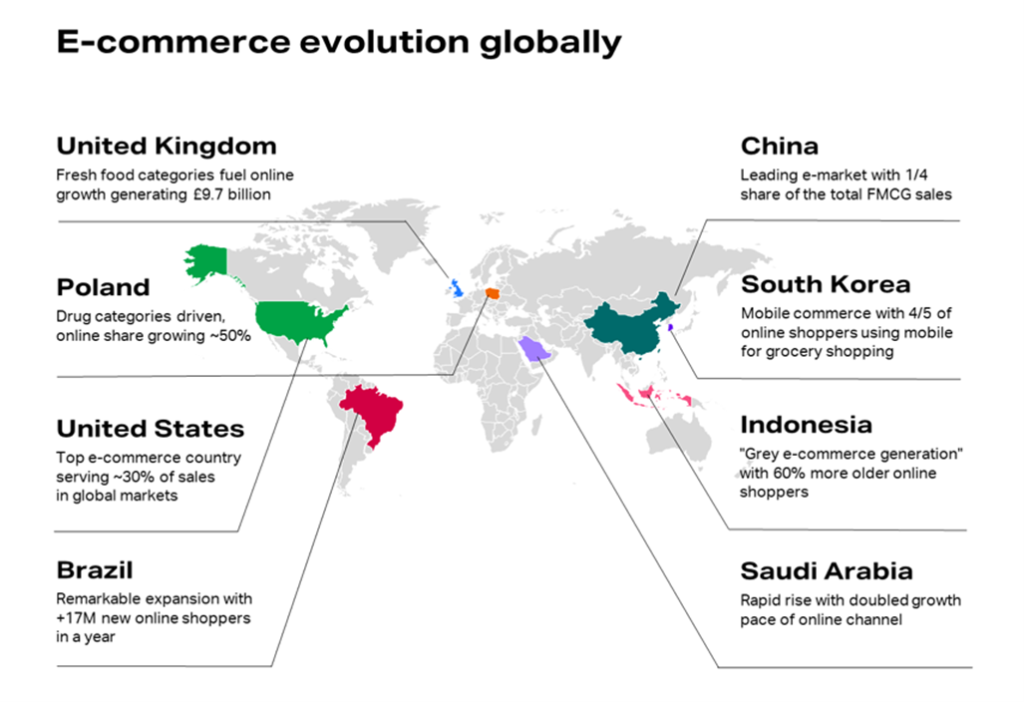Online Shopping Trends and Innovations
Table of Contents
Merits of E-commerce Trends. 7
Demerits of E-commerce Trends. 8
Introduction
Relentless technological advancement and shifting consumer behaviour have brought forward e-commerce as a catalyst for transformation in the retail landscape. According to Har et al. (2022), the growth of e-commerce platforms such as Amazon, Alibaba and eBay brought forth a revolution in retail with the e-commerce market witnessing a surge of 45.8% in online sales globally over the last two years. The primary purpose of this essay is to evaluate the emerging trends that are reshaping the e-commerce ecosystem. This essay argues on the implications of e-commerce for the future of retail, and the pivotal role of innovative trends in shaping this transformation. The essay primarily explores e-commerce before discussing, emerging trends, merits of e-commerce and demerits of e-commerce trends.
E-commerce

Fig.1. E-commerce evolution globally (NIQ, 2022).
The rise of e-commerce has reshaped engagement in retail, profoundly impacting daily lives and the business landscape. In 2020, global e-commerce retail revenue experienced a substantial growth of 25.7%, accounting for 18% of the overall market share in retail sales (Geva & Winter, 2022) This substantial increase reflects the convenience and accessibility of online shopping which has expanded consumer choices, offering a vast array of products and services at the click of a button, therefore, transforming traditional business models, empowering small entrepreneurs to reach a global audience. As shown in Fig. 1. e-commerce evolution can be witnessed globally with various countries integrating e-commerce to fuel their economy. Khan, et al. (2023), highlighted that the rise in e-commerce has disrupted major traditional industries. While e-commerce may have led to the closure of physical stores, however, it has encouraged innovation in the retail sector by fostering new types of businesses such as local delivery services and virtual showrooms, which can help maintain a sense of community. E-commerce is a harbinger of an increasingly personalized technologically driven future of shopping bringing forth significant disruption in the retail sector.
Emerging Trends

Fig. 2. Benefits of Personalization in E-Commerce (Sahin, 2023).
The integration of Artificial Intelligence (AI) is one of the most impactful trends in e-commerce for personalizing shopping experience. Monjur et al. (2023) found that the addition of AI in the business processes of e-commerce giants has been evidenced to reduce costs by at least 8% and improve sales by about 20%. As per Zimmermann et al. (2023), an increase in conversation rates can be achieved by leveraging AI to predict customer behaviour and provide personalized shopping recommendations. It is observed that AI-driven personalization utilizes customer data to curate product recommendations and tailor the shopping experience to individual preferences. As illustrated in Fig.2 it is found that customers are likely to buy more from brands that provide personalization which is found to increase sales by 20%. However, the growing complexity of personalization leads to concerns regarding consumer privacy (Weiss, 2020). Therefore, to balance personalization with privacy, businesses are implementing stringent security measures to ensure data privacy. In e-commerce, AI-driven personalization represents a substantial shift in the way customers interact with brands providing benefits that should not be overlooked.

Fig. 3. Virtual 360 Showroom of Yord (Yord, 2023).
The online shopping experience is on the verge of being redefined by the introduction of virtual showrooms, which provide an interactive and immersive platform for consumers. The interactive and immersive sensory shopping experience provided by Virtual Reality (VR) triggers consumers to impulsively purchase products (Chen et al., 2022). This trend enhances customer engagement by bridging the gap between the tactile experience of physical stores and the convenience of online shopping. Virtual 360 Showrooms such as the one by Yord demonstrated in Fig. 3, allow the user to view the items online while providing the feeling of walking through a store with the integration of online shopping. The research conducted by Chong et al. (2021) posits that the field of Virtual Reality (VR) encounters limitations, particularly in facilitating unrestricted user movement and navigation within the virtual space. Nonetheless, it is crucial to recognize that, while these limitations are real, they are not insurmountable. Continuous advancements are being made by developers in the virtual reality domain to address these challenges. The emergence of virtual showrooms represents a promising development for e-commerce, serving to heighten customer engagement and offering an intriguing insight into the prospective evolution of retail.
Merits of E-commerce Trends

Fig. 4. MarTech Trends in 2022 (ContactPigeon, 2022).
The incorporation of groundbreaking trends in e-commerce, exemplified in Fig. 4, has initiated a transformative wave in the retail sector. According to the study by Tyapkina and Erdyneeva (2021), these emerging trends in e-commerce have created new opportunities for smaller retailers and entrepreneurs, facilitating their entry into international markets. Additionally, as discussed by Pfeiffer et al. (2020), trends such as personalization and virtual reality shopping environments can be used to create a more emotionally engaging customer experience and increase conversion rates. It is observed that trends such as these can foster a sense of loyalty among customers because they feel understood by the retailer. The combined effect of various trends such as these can lead to an increase in sales as customers are presented with products, they are more likely to buy. Furthermore, it is observed that emerging trends such as Virtual 360 showrooms also reduce the uncertainty associated with online shopping. Furthermore, several e-commerce platforms offer easy access to smaller retailers in the global markets the utilization of AI can help identify the most promising markets for expansion based on market trends and consumer behaviour. The integration of innovative e-commerce trends has undeniably transformed the retail industry, offering opportunities for smaller businesses, enhancing customer engagement, and improving sales.
Demerits of E-commerce Trends
While emerging e-commerce trends carry multiple positive implications, they also concurrently give rise to negative consequences. According to Faishal et al. (2023), the inculcation of AI to automate tasks creates job displacement in various industries including e-commerce. Personalization leads to concerns regarding data privacy concerns which can erode trust and lead to regulatory issues. (Weiss, 2020). Additionally, as discussed by Shaffyahni and Nurjanah (2020), the implementation of e-commerce trends can be expensive, as it requires careful planning and investment in resources and technology tools. It is observed that job displacement caused by the adoption of AI can have significant social and economic consequences, including unemployment and the need for retraining and upskilling for those displaced workers. Facebook claimed to share data with advertisers however it was found that the data collected from the users was largely sold (John, 2017). Furthermore, the data collected during personalization in e-commerce platforms may collect large amounts of customer data and misuse or mishandling it can lead to a breach of trust and regulatory issues. It is also found that while the implementation of trends brings forth increased sales it subsequently contains a resource-intensive system that requires continuous monitoring and maintenance to ensure correct functionality. Striking a balance between innovation and responsible implementation is essential to harness the full potential of these trends while addressing their associated negative consequences.
Conclusion
The primary purpose of this essay was to explore the transformative trends in e-commerce that are reshaping the future of retail. This essay argued on the implications of e-commerce for the future of retail, and the pivotal role of innovative trends in shaping transformation. The essay highlighted two widely emerging trends that are identified as personalization and VR showrooms. The findings indicated that the e-commerce trends can significantly bring about positive implications with an increase in sales, customer loyalty and experience. However, the essay noted that the adoption of emerging trends can lead to data privacy concerns, job displacement and various other issues with e-commerce acting as a catalyst for change future retail will face unprecedented changes.
Reference
Chen, J. V., Ha, Q. A., & Vu, M. T. (2022). The influences of virtual reality shopping characteristics on consumers’ impulse buying behavior. International Journal of Human Computer Interaction, 39(17), 3473-3491. https://doi.org/10.1080/10447318.2022.2098566
Chong, H. T., Lim, C. K., Ahmed, M. F., Tan, K. L., & Mokhtar, M. B. (2021). Virtual reality usability and accessibility for cultural heritage practices: Challenges mapping and recommendations. Electronics, 10(12), 1430. https://doi.org/10.3390/electronics10121430
ContactPigeon (2022). Martech Trends 2022: 48 industry experts share their insights. Retrieved from https://blog.contactpigeon.com/martech-trends-2022/
Faishal, M., Mathew, S., Neikha, K., Pusa, K., & Zhimomi, T. (2023). The future of work: AI, automation, and the changing dynamics of developed economies. World Journal of Advanced Research and Reviews. https://doi.org/10.30574/wjarr.2023.18.3.1086
Geva, B., Peri, S., & Winter, R. (2022). International negotiable instruments. The Australian Year Book of International Law Online, 40(1), 358-362. https://doi.org/10.1163/26660229-04001017
Har, L. L., Rashid, U. K., Te Chuan, L., Sen, S. C., & Xia, L. Y. (2022). Revolution of the retail industry: From perspective of retail 1.0 to 4.0. Procedia Computer Science, 200, 1615-1625. https://doi.org/10.1016/j.procs.2022.01.362
John, N. A. (2017). The age of sharing. John Wiley & Sons.
Khan, Z., Zeng, J., Knight, G., Rajwani, T., & Pattnaik, C. (2023). Non-Market Strategies and disruptive innovation in the platform economy. Journal of International Management, 29(5), 101047.
https://doi.org/10.1016/j.intman.2023.101047
Monjur, M. E. I., Rifat, A. H., Islam, M. R., & Bhuiyan, M. R. (2023). The Impact of Artificial Intelligence on International Trade: Evidence from B2C Giant E-Commerce (Amazon, Alibaba, Shopify, eBay). Open Journal of Business and Management, 11(5), 2389-2401. 10.4236/ojbm.2023.115132
NIQ (2022). The evolution of e-commerce globally. Retrieved from https://nielseniq.com/global/en/insights/analysis/2022/the-evolution-of-e-commerce-globally/
Pfeiffer, J., Pfeiffer, T., Meißner, M., & Weiss, E. (2020). Eye-Tracking-Based Classification of Information Search Behavior Using Machine Learning: Evidence from Experiments in Physical Shops and Virtual Reality Shopping Environments. Inf. Syst. Res., 31, 675-691. 10.1287/isre.2019.0907
Sahin, B. (2023, February 24). E-Commerce Personalization: Your Complete Guide. Bloomreach. https://www.bloomreach.com/en/blog/2017/ecommerce-personalization
Shaffyahni, E.R., & Nurjanah, I. (2020). E-Commerce Application and Achievement of Competitive Advantage. In A. Herwany, E. Febrian, A. Gunardi, & D. R. Indika (Eds.), Economic and Development (pp. 1615-1625). Jakarta: Redwhite Press. 10.3390/su7021411
Tyapkina, M.F., & Erdyneeva, S. (2021). Trends And Prospects For The Development Of Electronic Commerce In Russia. Scientific Review Theory and Practice, 11(2), 525-533. 10.35679/2226-0226-2021-11-2-525-533
Weiss, C. (2020). Transformative technologies and the loss of privacy. Fashion, Style & Popular Culture, 7(2-3), 351-365. https://doi.org/10.1386/fspc_00023_1
Yord (2023). Virtual 360 Showroom Fashion. Retrieved from https://virtualshowroom.digital/fashion/
Zimmermann, R., Mora, D., Cirqueira, D., Helfert, M., Bezbradica, M., Werth, D., Weitzl, W.J., Riedl, R. & Auinger, A. (2023). Enhancing brick-and-mortar store shopping experience with an augmented reality shopping assistant application using personalized recommendations and explainable artificial intelligence. Journal of Research in Interactive Marketing, 17(2), 273-298. https://doi.org/10.1108/JRIM-09-2021-0237